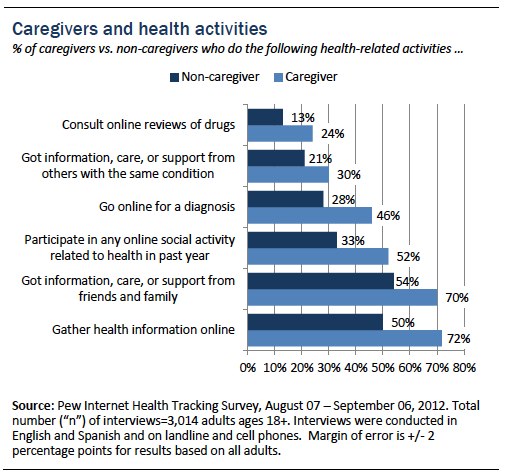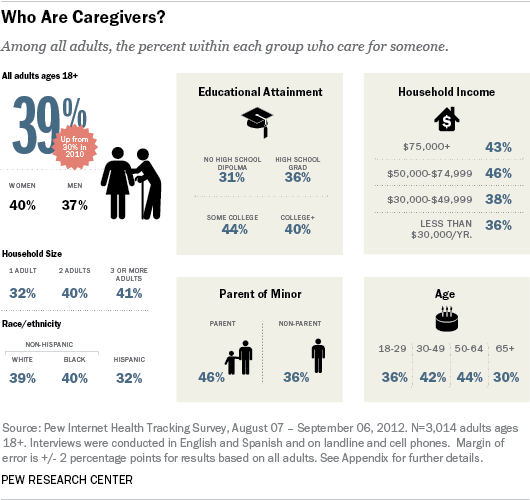39% of U.S. adults are caregivers and many navigate health care with the help of technology
Four in ten adults in the U.S. are caring for an adult or child with significant health issues, up from 30% in 2010. Caring for a loved one is an activity that cuts across most demographic groups, but is especially prevalent among adults ages 30 to 64, a group traditionally still in the workforce.
Caregivers are highly engaged in the pursuit of health information, support, care, and advice, both online and offline, and do many health-related activities at higher levels than non-caregivers.

Indeed, being a caregiver is independently associated with key health-related activities. When controlling for age, income, education, ethnicity, and good overall health, caregivers are more likely than other adults to:
- Gather health information online, particularly about medical problems, treatments, and drugs.
- Gather health information offline, from clinicians, friends, family, and others who share the same health condition.
- Go online specifically to try to figure out what condition they or someone else might have.
- Consult online reviews about drugs and other treatments.
- Track their own weight, diet, exercise routine, or other health indicator.
- Read online about someone else’s personal health experience (which, in the case of caregivers, could be related to their own or their loved one’s condition).
- Go online to find others with similar health concerns (again, there may be dual motivations to connect — to find more information about handling caregiver stress, for example, or about their loved one’s health challenges).
In a previous study by the Pew Research Center, 47% of U.S. adults say it is likely that, at some point in their life, they will be responsible for caring for an aging parent or another elderly family member.1 Demographic patterns bear out this prediction: People ages 65 and older represented 12.4% of the U.S. population in the year 2000 but are expected to be 19% of the population by 2030.2
This survey finds that fully 75% of U.S. adults age 65 and older are living with a chronic condition such as high blood pressure, diabetes, or heart disease. Numerous studies have shown that the day to day management of these complex medical cases falls squarely on family members and friends who may not be trained. But, as this study shows, caregivers are turning to every resource available to get the information and support they need.
39% of caregivers manage medications for a loved one; few use tech to do so
Thirty-nine percent of caregivers manage medications for a loved one, such as checking to be sure pills are taken properly or refilling prescriptions. Just 7% of caregivers use online or mobile tools, such as websites or apps, to do so.
Nine in ten caregivers own a cell phone and one-third have used it to gather health information
Eighty-seven percent of caregivers in the U.S. own a cell phone and, of those, 37% say they have used their phone to look for health or medical information online. This is a significantly higher than the rate of mobile health search among non-caregivers at the time of the survey: 84% of non-caregivers own a cell phone and 27% have used their phone to look online for health information.
Most caregivers say the internet is helpful to them
When asked about the specific impact of the internet:
- 59% of caregivers with internet access say that online resources have been helpful to their ability to provide care and support for the person in their care.
- 52% of caregivers with internet access say that online resources have been helpful to their ability to cope with the stress of being a caregiver.

About this study
The results reported here come from a nationwide survey of 3,014 adults living in the United States. Telephone interviews were conducted by landline (1,808) and cell phone (1,206, including 624 without a landline phone). The survey was conducted by Princeton Survey Research Associates International. Interviews were done in English and Spanish by Princeton Data Source from August 7 to September 6, 2012. Statistical results are weighted to correct known demographic discrepancies. The margin of sampling error for the complete set of weighted data is ±2.4 percentage points. In this survey there are 1,171 respondents who are caregivers. Margin of error for results based on caregivers is ±4 percentage points.
The Pew Internet & American Life Project is an initiative of the Pew Research Center, a nonprofit “fact tank” that provides information on the issues, attitudes and trends shaping America and the world. The Project is nonpartisan and takes no position on policy issues. Support for the Project is provided by the Pew Charitable Trusts.
Support for this study was provided by the California HealthCare Foundation, an independent philanthropy committed to improving the way health care is delivered and financed in California.
The authors gratefully acknowledge the contributions of community peer reviewers Denise Brown, Lynn Feinberg, Rajiv Mehta, John Novack, and MaryAnne Sterling.




